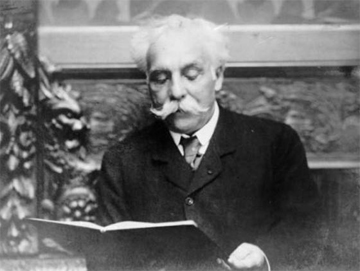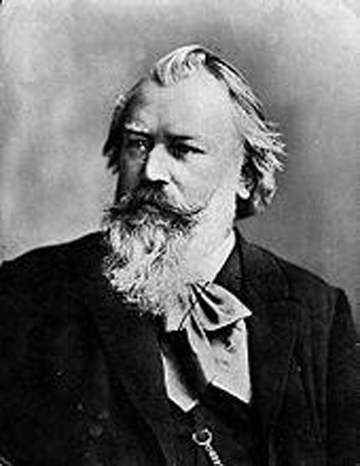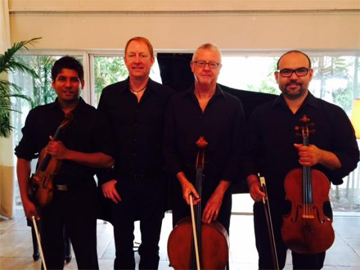
If a string quartet is that magical blend of instruments that composers, players and audiences adore, then a piano quartet is a close second. Musical luminaries such as Mozart, Schumann, Beethoven, Brahms, Dvořák and Fauré wrote works for violin, viola, cello and piano ensembles.
The South Beach Chamber Ensemble, Miami’s resident string quartet, served up piano quartets by Brahms and Fauré on May 14 at the Coral Gables Museum and May 17 at the Miami Beach Botanical Garden. This was the final offering of SBCE’s 18th season.

Tony Seepersad (violin), Rafael Ramirez (viola), Michael Andrews (cello) and guest pianist Michael Linville, played heartily to a small audience of chamber music lovers (except for the oblivious lady in the front row who kept checking the emails on her iPhone).
Linville is currently Associate Dean and Director of Chamber Music Activities for the New World Symphony, founded by Michael Tilson Thomas.
Brahms Piano Quartet in C minor, Op. 60 is a complex and passionate piece, sometimes called the Werther Quartet (referring to Goethe’s “The Sorrows of Young Werther.”). The similarities between Werther’s ardor for his married love interest, Lotte, and the fervor between Brahms and Clara Schumann, composer, pianist and Robert’s wife, are obvious.

After an attention-getting chord from the piano, the three strings appeared to be uttering the name "Clara, Clara," magnified as the piano took possession of the motif. This first movement boasted a sonata form – the “Clara” theme exposed, developed and recapitulated – furnished with strident textures and gentle phrases.
The theme was expertly tossed from player to player, the Museum hall acoustics promoting the synchronized dynamics. Linville was appropriately evenhanded, his compatriots sure and confident through to the movement’s mysterious ending.
The Scherzo featured Linville in a full gallop, perfectly in sync with the strings through this short second movement. In the slow third, Andrews rendered an exquisitely simple cello solo, his playing as lovely and honest as was the melody. Seepersad and Ramierz joined Andrews, creating luxurious harmonies as Linville maintained the delicate accompaniment. Each voice of the foursome was distinct in this rare conversation, all finishing with a rising element that blended into a soothing chord.
The final movement was loaded with vitality, Linville speedily underscoring Seepersad with the restless melody. The strings held to the haunting theme as the piano continued on its relentless path, resounding influences of Haydn and Beethoven palpable in the music. Linville took his turn with the melody and the ensem quietly approached the ending, finishing with two confident chords.
All four of these consummate players were committed, sharing the stage equally, Linville often referencing the others during the piece.

Gabriel Fauré was an A-list French composer and a contemporary of Brahms, well known for his harmonic and melodic invention in such works as Pavane and Clair de lune.
In the first movement of Fauré’s Piano Quartet in G minor, Op. 45, the piano emerged with the melody, and things brewed up quickly. Each player spoke out in turn, then settled in to a calming passage. Seepersad’s violin was a highlight with a characteristic Fauré signature — a flowing element laced into the melody, enchanting, pure, precise, and never overwrought — while Linville underscored with a characteristic rippling piano.
The spotlight was on Linville in the second, running with the Slavic-flavored passage, the strings following him adeptly. Ramirez was featured in the Adagio third, delivering a rueful melody with clarity and feeling. Linville’s piano engaged with the viola and then Seepersad took the wistful theme. The quartet then circled the piano, lifting the mood. Ramirez returned with the subdued figure and the quartet ended the movement with discreet resolve.
The big entrance of the fourth movement, a furious motif on a three-count, quickly developed in the lower strings, piano and violin. The piano broke away into a falling and rising dance melody, the strings echoing. The piano stirred the pot while all the players weaved variations of the first motif and dance theme together with a wide variety of cadences. This multilayered movement filled the hall with so much music that, after a vigorous sprint to the finish, the enthusiastic crowd could not help but be on their feet.




